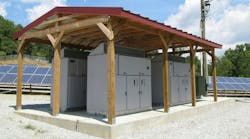Natural gas will continue to be the top fuel source for U.S. electricity generation in the near and distant future, followed by wind, according to a new report by the American Public Power Association that looks at the nation’s generating capacity.
A pattern has emerged over the past several years in terms of new generating capacity development, said the report, America’s Electricity Generation Capacity — APPA’s 10th annual report on current and forthcoming electricity generation capacity in the United States by types of fuel, location, and ownership.
"Natural gas and wind are the major sources of new generation, though solar power continues to make gains," said Paul Zummo, APPA’s manager of policy research and analysis, who wrote the report. Nearly half of all new capacity is fueled by natural gas, “and this is a trend that is likely to continue for the immediate future,” Zummo said.
The report points out that the current wave of new generation, although large, “is just barely keeping ahead of retirements.”
In 2015, retirements outpaced additions
Even though approximately twice as much utility-scale generation has been added to the grid since 2008 as has been retired, retirements actually outpaced capacity additions in 2015. Environmental regulations, including the Environmental Protection Agency’s Clean Power Plan, “could lead to many more retirements, especially of coal capacity,” and if that happens it is likely that this capacity would be replaced by natural gas, the report says.
Currently, the U.S. has just over 1.17 million MW of generation capacity, according to the report. The largest fuel source is natural gas, accounting for nearly 43 percent of all capacity. Coal is the second largest generation source, with a share of just over 26 percent. Nuclear, hydro, and wind power together account for about 24 percent of capacity. Solar currently makes up just over one percent.
The report analyzes prospective generation capacity in four categories — under construction, permitted, application pending, and proposed.
Nearly 341,000 MW of new generation capacity is under development in the United States — 87,000 MW under construction or permitted, and just under 254,000 MW proposed or pending application.
Natural gas will continue to be the top fuel source, followed by wind, but a growing amount of generating capacity is expected to be fueled by solar. Today, solar constitutes just over 11 percent of all capacity for plants under construction and that have permits to start building.
The report shows future generating capacity by regional transmission organization region. Approximately two-thirds of future generating capacity is projected to be in RTO regions, and one-third in regions without RTOs — the same as the current U.S. capacity mix.
The report looks at capacity additions, cancellations, and retirements from 2008 to 2015, and finds that natural gas is the only resource for which additions outnumbered cancellations. For all other resources, far more capacity was canceled than was added.
More than 18,000 MW of capacity was retired in 2015 alone, of which coal accounted for almost 80 percent, according to the report.
The analysis also includes information on capacity factors and construction costs. Costs to construct new generation “vary considerably by fuel type, with natural gas generally cheaper on a per-MW basis than almost all forms of generation, and renewable forms of generation being more expensive,” the report says.
While the overall capacity mix in the United States is expected to change, it will do so at a gradual pace, the report says.

Voice your opinion!
Voice your opinion!
To join the conversation, and become an exclusive member of T&D World, create an account today!
Latest from Renewables
Latest from Renewables

